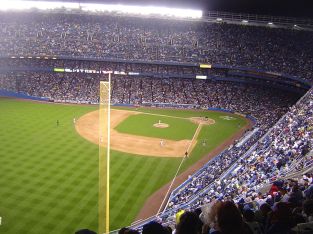Over the past two decades data has made it evident that the offensive production in Major League Baseball has been on the decline, and as one can assume, due to this pitchers have been rising to greatness.
To start, the average number of runs scored has decreased. According to SportingCharts, the number of runs scored each year leads to inconclusive evidence. However, once you calculate the total number of games played each year and find the total number of runs scored in each of those years the evidence is found. From the years 1990 to 2005, the league’s runs per game average hovered between nine and ten runs per game. To be exact, the average over that fifteen year time span amounts to 9.42 runs scored per game. From 2005 to 2014, the average runs scored per game has decreased. Over the past ten years, on average, 8.92 runs have been scored each game. Although this does not seem to be an exponential change, the number of runs scored on average each year has been on the decline since 2005.
With the decline of the average number of runs scored each game comes the decline of the number of home runs hit each year. SportingCharts shows the peak of the home run ball in the 2000 season when 5,693 home runs were hit. Ever since 2000, the number of home runs hit each year has been decreasing; however, the average of home runs hit up to 2000, and the average of home runs hit after does not correlate with the overall decrease in homerun totals. Actually, the average number of home runs from 2000 on (4,957) is higher than the average over the seasons leading up to 2000 (4,276). So, while the number of home runs each season has been decreasing since 2000, the average over the course of the past 15 years has actually increased.
Now, while in essence the overall offensive game of baseball seems as though it may be on the decline, conversely the pitching statistics have been rising. Again, SportingCharts compiled statistics regarding the number of strikeouts over the past 25 years. The number of strikeouts has increased greatly since 1990. In 1990, pitchers recorded just 23,853 strikeouts. In 2014, the number almost doubled. Pitchers mounted a total of 37,441 strikeouts last year.
As a result of these converse statistics, baseball analysts have been trying to figure out what is causing this new phenomenon. Some analysts cite the possibility of an expanding strike zone; this would explain the reasoning behind the increasing number of strikeouts. There are different studies that do support the idea of an expanding strike zone. In just five years, the strike zone has expanded by 50 square inches. Although this could definitely be a factor in the increased number of strikeouts, I do not think that the expanded strike zone accounts for the decrease in the number of home runs and runs scored over the past two decades.
Rather than the expanding strike zone, I think a major factor in the decreased offensive production and the stronger pitching performances has to do with the post-steroid era.
When looking at the numbers there are obvious spikes in offensive numbers before 2006. The end of the 90s brought with it exciting homerun races in which players were posting homerun numbers never seen before. These homerun races involved Barry Bonds, Mark McGuire and Sammy Sosa – all of which were using steroids. In 2006, the Joint Drug Prevention and Treatment Program was established by Major League Baseball which put an end to a major portion of players using PEDs in the MLB which lead to decreased offensive production. During the time period where PEDs were more apparent in the league, offensive production was much more prevalent than it is today.





